OSI Model and TCP/IP Protocol Suite
VerifiedAdded on 2023/04/23
|7
|1495
|490
AI Summary
This document explains the correlation between OSI model and TCP/IP protocol suite. It also explains the functions of each layer and services provided by the application layer.
Contribute Materials
Your contribution can guide someone’s learning journey. Share your
documents today.

Running head: ASSIGNMENT 1
ASSIGNMENT 1
Name of Student
Name of University
Author’s Note
ASSIGNMENT 1
Name of Student
Name of University
Author’s Note
Secure Best Marks with AI Grader
Need help grading? Try our AI Grader for instant feedback on your assignments.
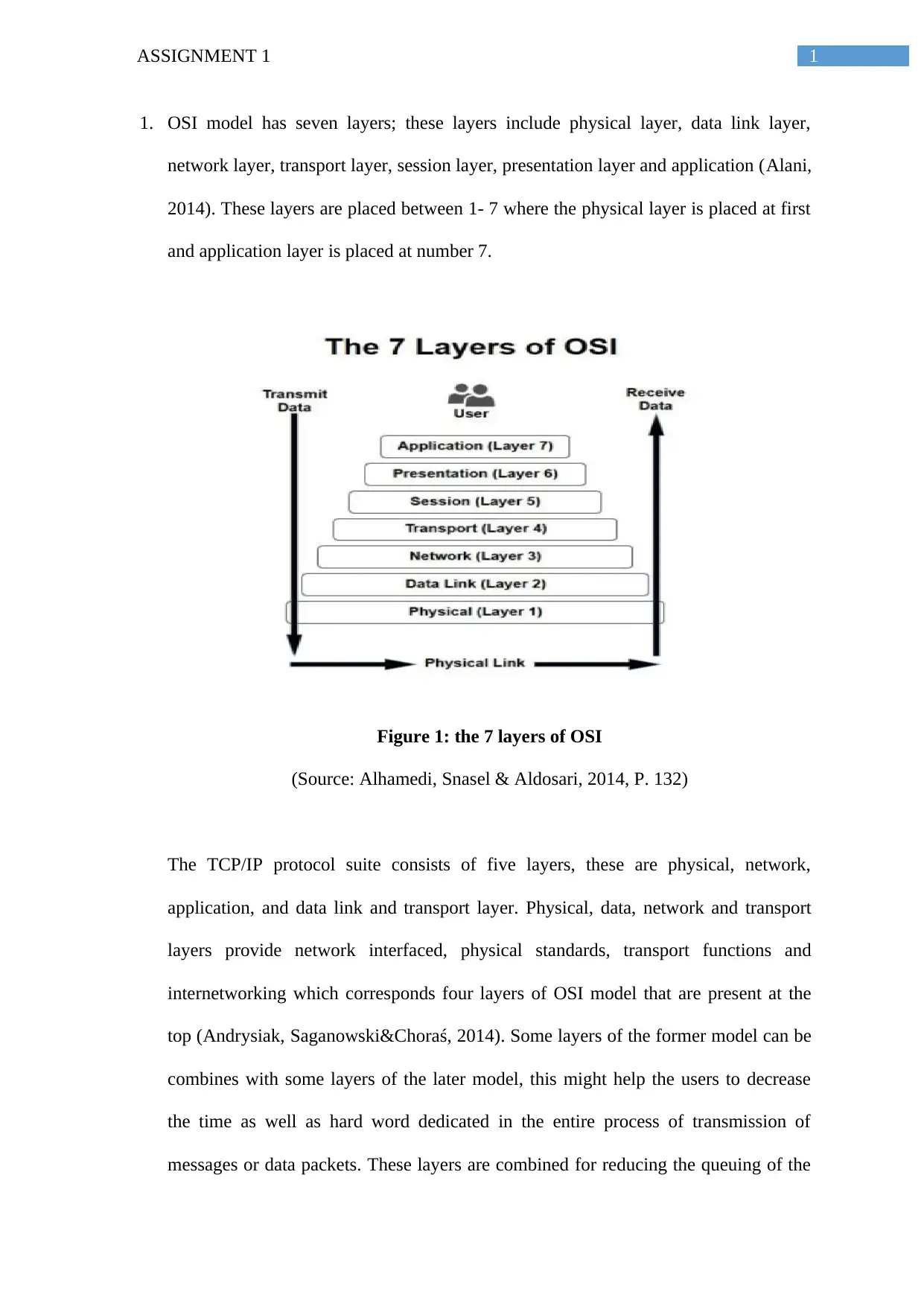
1ASSIGNMENT 1
1. OSI model has seven layers; these layers include physical layer, data link layer,
network layer, transport layer, session layer, presentation layer and application (Alani,
2014). These layers are placed between 1- 7 where the physical layer is placed at first
and application layer is placed at number 7.
Figure 1: the 7 layers of OSI
(Source: Alhamedi, Snasel & Aldosari, 2014, P. 132)
The TCP/IP protocol suite consists of five layers, these are physical, network,
application, and data link and transport layer. Physical, data, network and transport
layers provide network interfaced, physical standards, transport functions and
internetworking which corresponds four layers of OSI model that are present at the
top (Andrysiak, Saganowski&Choraś, 2014). Some layers of the former model can be
combines with some layers of the later model, this might help the users to decrease
the time as well as hard word dedicated in the entire process of transmission of
messages or data packets. These layers are combined for reducing the queuing of the
1. OSI model has seven layers; these layers include physical layer, data link layer,
network layer, transport layer, session layer, presentation layer and application (Alani,
2014). These layers are placed between 1- 7 where the physical layer is placed at first
and application layer is placed at number 7.
Figure 1: the 7 layers of OSI
(Source: Alhamedi, Snasel & Aldosari, 2014, P. 132)
The TCP/IP protocol suite consists of five layers, these are physical, network,
application, and data link and transport layer. Physical, data, network and transport
layers provide network interfaced, physical standards, transport functions and
internetworking which corresponds four layers of OSI model that are present at the
top (Andrysiak, Saganowski&Choraś, 2014). Some layers of the former model can be
combines with some layers of the later model, this might help the users to decrease
the time as well as hard word dedicated in the entire process of transmission of
messages or data packets. These layers are combined for reducing the queuing of the
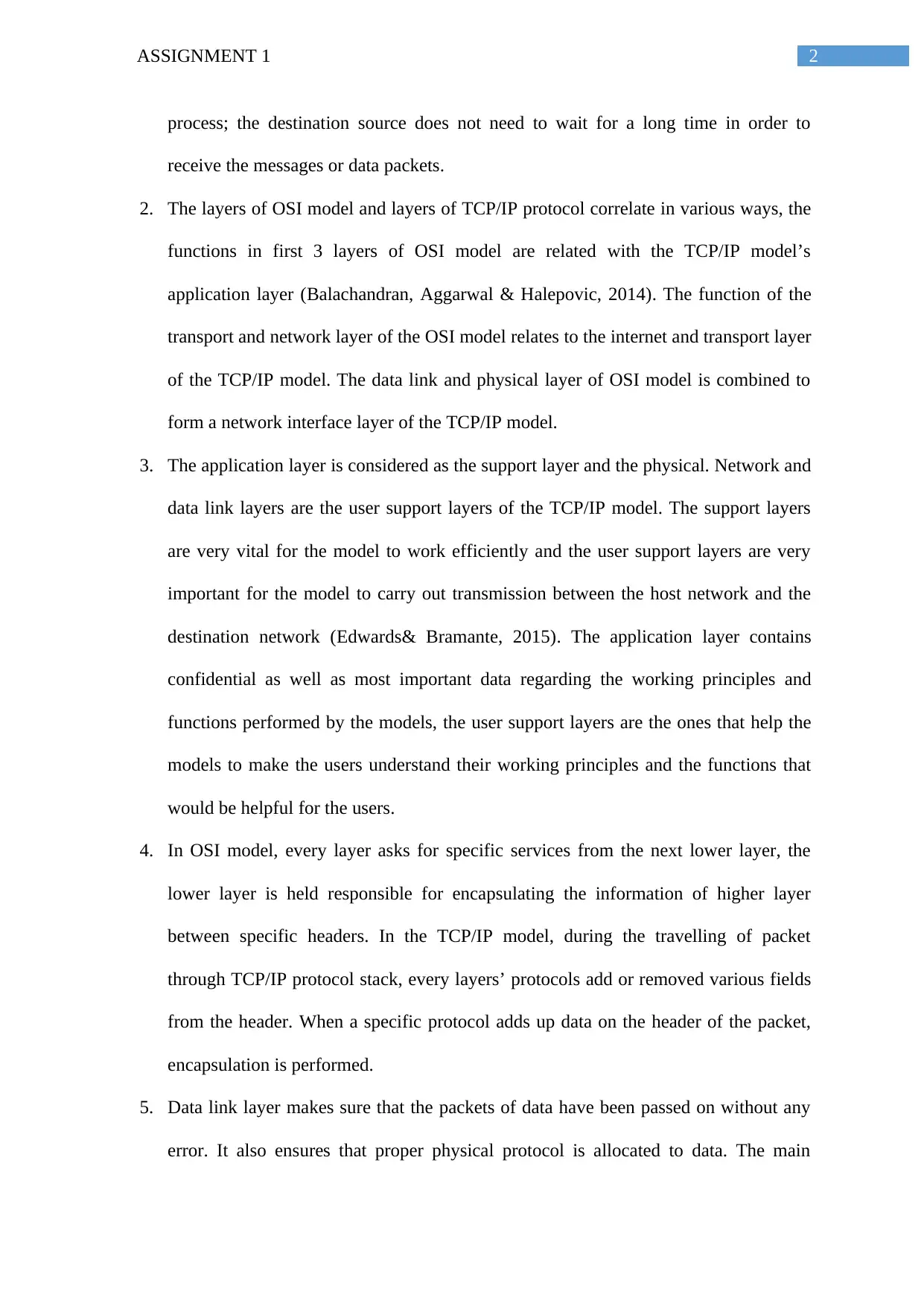
2ASSIGNMENT 1
process; the destination source does not need to wait for a long time in order to
receive the messages or data packets.
2. The layers of OSI model and layers of TCP/IP protocol correlate in various ways, the
functions in first 3 layers of OSI model are related with the TCP/IP model’s
application layer (Balachandran, Aggarwal & Halepovic, 2014). The function of the
transport and network layer of the OSI model relates to the internet and transport layer
of the TCP/IP model. The data link and physical layer of OSI model is combined to
form a network interface layer of the TCP/IP model.
3. The application layer is considered as the support layer and the physical. Network and
data link layers are the user support layers of the TCP/IP model. The support layers
are very vital for the model to work efficiently and the user support layers are very
important for the model to carry out transmission between the host network and the
destination network (Edwards& Bramante, 2015). The application layer contains
confidential as well as most important data regarding the working principles and
functions performed by the models, the user support layers are the ones that help the
models to make the users understand their working principles and the functions that
would be helpful for the users.
4. In OSI model, every layer asks for specific services from the next lower layer, the
lower layer is held responsible for encapsulating the information of higher layer
between specific headers. In the TCP/IP model, during the travelling of packet
through TCP/IP protocol stack, every layers’ protocols add or removed various fields
from the header. When a specific protocol adds up data on the header of the packet,
encapsulation is performed.
5. Data link layer makes sure that the packets of data have been passed on without any
error. It also ensures that proper physical protocol is allocated to data. The main
process; the destination source does not need to wait for a long time in order to
receive the messages or data packets.
2. The layers of OSI model and layers of TCP/IP protocol correlate in various ways, the
functions in first 3 layers of OSI model are related with the TCP/IP model’s
application layer (Balachandran, Aggarwal & Halepovic, 2014). The function of the
transport and network layer of the OSI model relates to the internet and transport layer
of the TCP/IP model. The data link and physical layer of OSI model is combined to
form a network interface layer of the TCP/IP model.
3. The application layer is considered as the support layer and the physical. Network and
data link layers are the user support layers of the TCP/IP model. The support layers
are very vital for the model to work efficiently and the user support layers are very
important for the model to carry out transmission between the host network and the
destination network (Edwards& Bramante, 2015). The application layer contains
confidential as well as most important data regarding the working principles and
functions performed by the models, the user support layers are the ones that help the
models to make the users understand their working principles and the functions that
would be helpful for the users.
4. In OSI model, every layer asks for specific services from the next lower layer, the
lower layer is held responsible for encapsulating the information of higher layer
between specific headers. In the TCP/IP model, during the travelling of packet
through TCP/IP protocol stack, every layers’ protocols add or removed various fields
from the header. When a specific protocol adds up data on the header of the packet,
encapsulation is performed.
5. Data link layer makes sure that the packets of data have been passed on without any
error. It also ensures that proper physical protocol is allocated to data. The main

3ASSIGNMENT 1
functions of the data link layer include the errors related to transmission; provide a
properly described interface for the network layer as well as regulation of data flow.
6. Transport layer carried out the delivery of the message that is usually process-to-
process, the network layer looks after the host-to-host delivery of specific data
packets.
7. A different mechanism for checking must be included in the transport layer because
routers that are present between the links might not be perfect and the mechanism is
supposed to prevent bit flips in it (Goralski, 2017). Moreover multiple checks help in
monitoring, an error among the nodes might be detected in data link layer but in care
an error is detected at the node it can never be detected by data link layer, hence
another mechanism is required.
8. Some functions of network layer include, it helps in delivering the data in the form of
packets, it delivers packets among source hosts and destination hosts, and this layer is
used usually when a user wants to send data over networks that are different in nature
and this layer helps in routing as well.
9. Transport layer has numerous functions, error control is one of them, and transport
layer ensures that data is not lost in the middle of a transmission (Herbuś,
Kost&Reclik,. 2015)Transport layer also helps in reassembling messages because
every message is divided into segments.
10. With the help of logical address a system identifies a network, after the identification
is done, the physical address is used in order to identify the host present in the
network (Kota, Goyal&Goyal, 2016). The port address is utilized in order to identify a
particular application that is running on destination machine.
11. Some services provided by application layer are as follows
Standard TCP/IP services like tftp, telnet commands and ftp.
functions of the data link layer include the errors related to transmission; provide a
properly described interface for the network layer as well as regulation of data flow.
6. Transport layer carried out the delivery of the message that is usually process-to-
process, the network layer looks after the host-to-host delivery of specific data
packets.
7. A different mechanism for checking must be included in the transport layer because
routers that are present between the links might not be perfect and the mechanism is
supposed to prevent bit flips in it (Goralski, 2017). Moreover multiple checks help in
monitoring, an error among the nodes might be detected in data link layer but in care
an error is detected at the node it can never be detected by data link layer, hence
another mechanism is required.
8. Some functions of network layer include, it helps in delivering the data in the form of
packets, it delivers packets among source hosts and destination hosts, and this layer is
used usually when a user wants to send data over networks that are different in nature
and this layer helps in routing as well.
9. Transport layer has numerous functions, error control is one of them, and transport
layer ensures that data is not lost in the middle of a transmission (Herbuś,
Kost&Reclik,. 2015)Transport layer also helps in reassembling messages because
every message is divided into segments.
10. With the help of logical address a system identifies a network, after the identification
is done, the physical address is used in order to identify the host present in the
network (Kota, Goyal&Goyal, 2016). The port address is utilized in order to identify a
particular application that is running on destination machine.
11. Some services provided by application layer are as follows
Standard TCP/IP services like tftp, telnet commands and ftp.
Secure Best Marks with AI Grader
Need help grading? Try our AI Grader for instant feedback on your assignments.
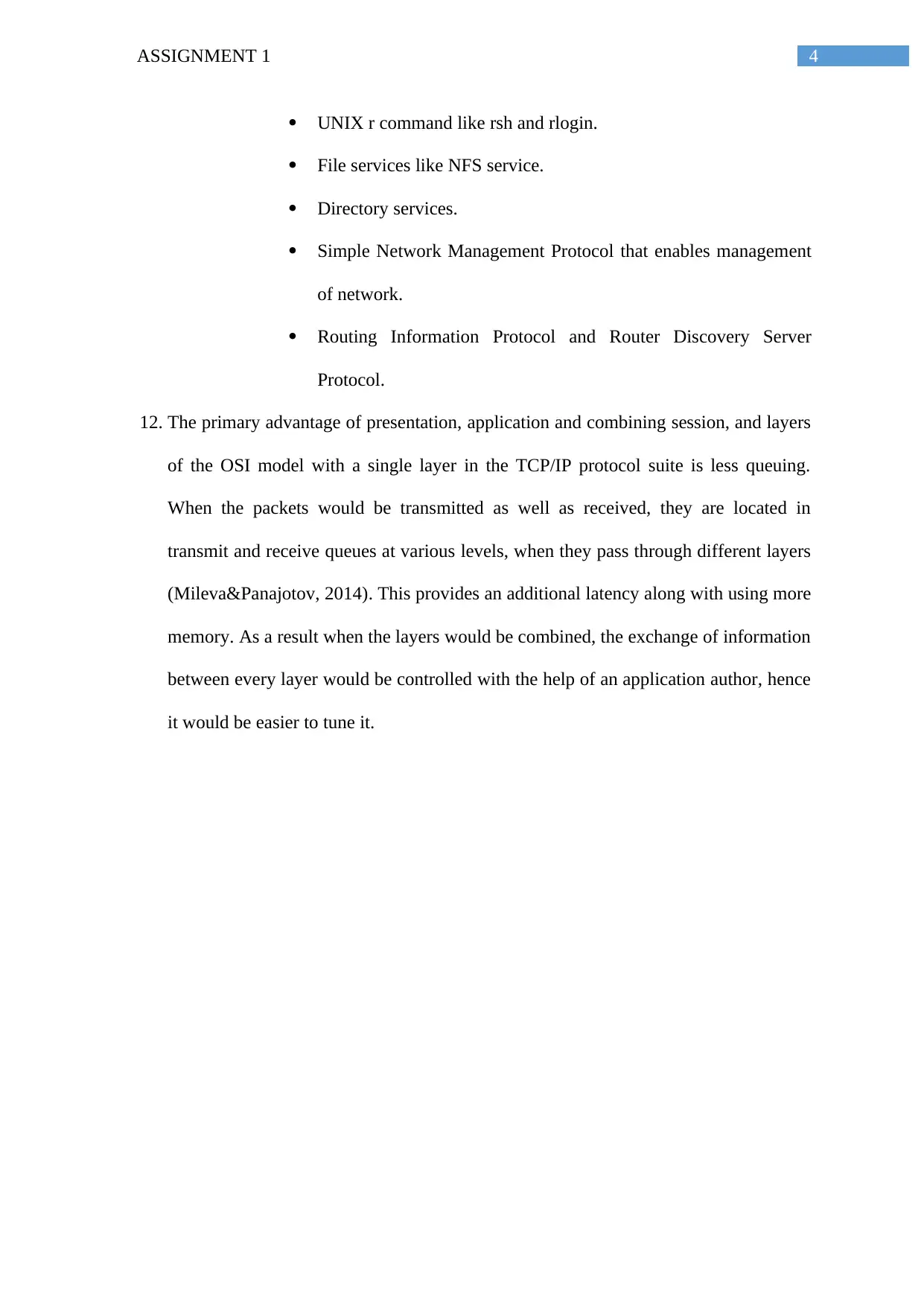
4ASSIGNMENT 1
UNIX r command like rsh and rlogin.
File services like NFS service.
Directory services.
Simple Network Management Protocol that enables management
of network.
Routing Information Protocol and Router Discovery Server
Protocol.
12. The primary advantage of presentation, application and combining session, and layers
of the OSI model with a single layer in the TCP/IP protocol suite is less queuing.
When the packets would be transmitted as well as received, they are located in
transmit and receive queues at various levels, when they pass through different layers
(Mileva&Panajotov, 2014). This provides an additional latency along with using more
memory. As a result when the layers would be combined, the exchange of information
between every layer would be controlled with the help of an application author, hence
it would be easier to tune it.
UNIX r command like rsh and rlogin.
File services like NFS service.
Directory services.
Simple Network Management Protocol that enables management
of network.
Routing Information Protocol and Router Discovery Server
Protocol.
12. The primary advantage of presentation, application and combining session, and layers
of the OSI model with a single layer in the TCP/IP protocol suite is less queuing.
When the packets would be transmitted as well as received, they are located in
transmit and receive queues at various levels, when they pass through different layers
(Mileva&Panajotov, 2014). This provides an additional latency along with using more
memory. As a result when the layers would be combined, the exchange of information
between every layer would be controlled with the help of an application author, hence
it would be easier to tune it.
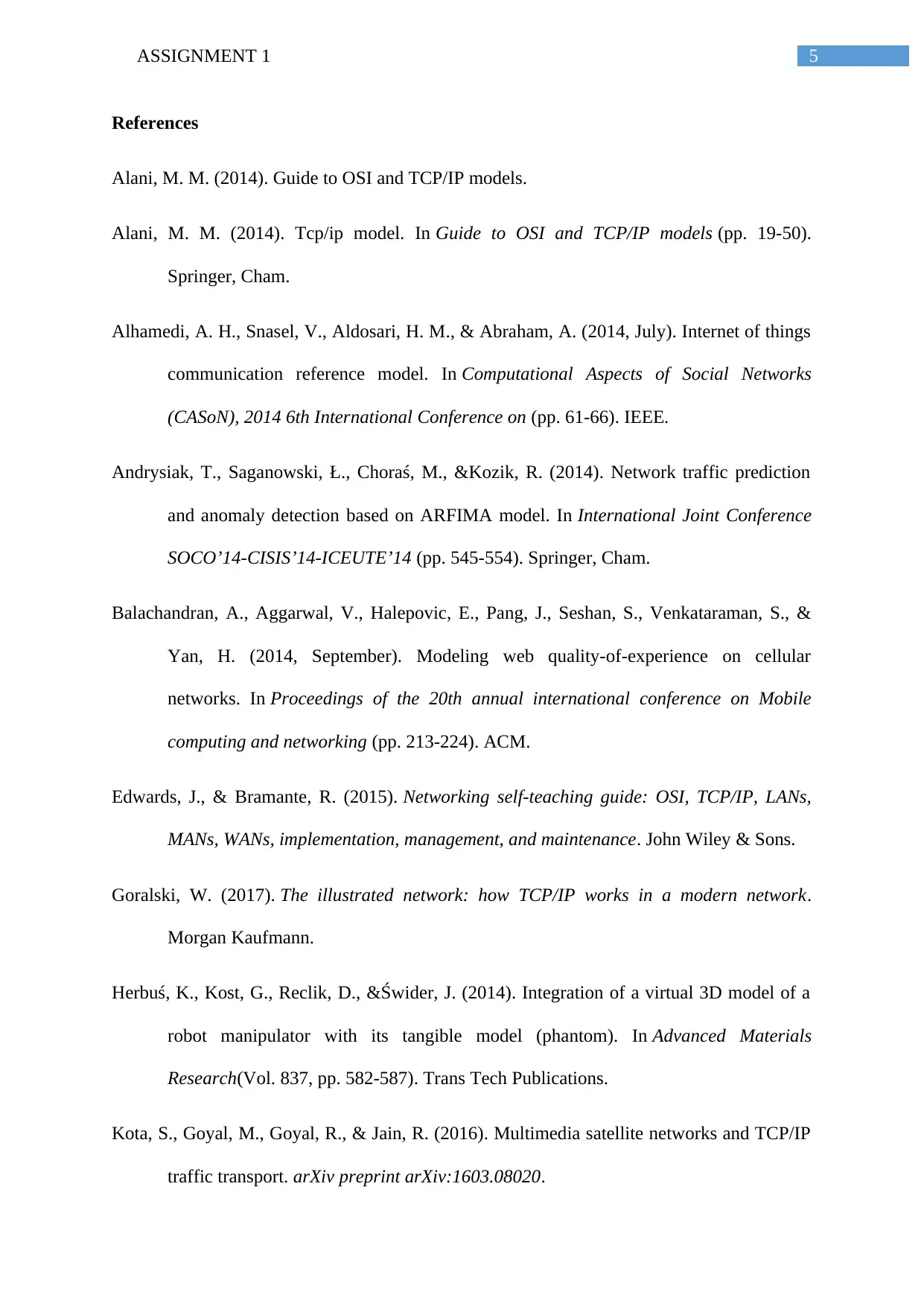
5ASSIGNMENT 1
References
Alani, M. M. (2014). Guide to OSI and TCP/IP models.
Alani, M. M. (2014). Tcp/ip model. In Guide to OSI and TCP/IP models (pp. 19-50).
Springer, Cham.
Alhamedi, A. H., Snasel, V., Aldosari, H. M., & Abraham, A. (2014, July). Internet of things
communication reference model. In Computational Aspects of Social Networks
(CASoN), 2014 6th International Conference on (pp. 61-66). IEEE.
Andrysiak, T., Saganowski, Ł., Choraś, M., &Kozik, R. (2014). Network traffic prediction
and anomaly detection based on ARFIMA model. In International Joint Conference
SOCO’14-CISIS’14-ICEUTE’14 (pp. 545-554). Springer, Cham.
Balachandran, A., Aggarwal, V., Halepovic, E., Pang, J., Seshan, S., Venkataraman, S., &
Yan, H. (2014, September). Modeling web quality-of-experience on cellular
networks. In Proceedings of the 20th annual international conference on Mobile
computing and networking (pp. 213-224). ACM.
Edwards, J., & Bramante, R. (2015). Networking self-teaching guide: OSI, TCP/IP, LANs,
MANs, WANs, implementation, management, and maintenance. John Wiley & Sons.
Goralski, W. (2017). The illustrated network: how TCP/IP works in a modern network.
Morgan Kaufmann.
Herbuś, K., Kost, G., Reclik, D., &Świder, J. (2014). Integration of a virtual 3D model of a
robot manipulator with its tangible model (phantom). In Advanced Materials
Research(Vol. 837, pp. 582-587). Trans Tech Publications.
Kota, S., Goyal, M., Goyal, R., & Jain, R. (2016). Multimedia satellite networks and TCP/IP
traffic transport. arXiv preprint arXiv:1603.08020.
References
Alani, M. M. (2014). Guide to OSI and TCP/IP models.
Alani, M. M. (2014). Tcp/ip model. In Guide to OSI and TCP/IP models (pp. 19-50).
Springer, Cham.
Alhamedi, A. H., Snasel, V., Aldosari, H. M., & Abraham, A. (2014, July). Internet of things
communication reference model. In Computational Aspects of Social Networks
(CASoN), 2014 6th International Conference on (pp. 61-66). IEEE.
Andrysiak, T., Saganowski, Ł., Choraś, M., &Kozik, R. (2014). Network traffic prediction
and anomaly detection based on ARFIMA model. In International Joint Conference
SOCO’14-CISIS’14-ICEUTE’14 (pp. 545-554). Springer, Cham.
Balachandran, A., Aggarwal, V., Halepovic, E., Pang, J., Seshan, S., Venkataraman, S., &
Yan, H. (2014, September). Modeling web quality-of-experience on cellular
networks. In Proceedings of the 20th annual international conference on Mobile
computing and networking (pp. 213-224). ACM.
Edwards, J., & Bramante, R. (2015). Networking self-teaching guide: OSI, TCP/IP, LANs,
MANs, WANs, implementation, management, and maintenance. John Wiley & Sons.
Goralski, W. (2017). The illustrated network: how TCP/IP works in a modern network.
Morgan Kaufmann.
Herbuś, K., Kost, G., Reclik, D., &Świder, J. (2014). Integration of a virtual 3D model of a
robot manipulator with its tangible model (phantom). In Advanced Materials
Research(Vol. 837, pp. 582-587). Trans Tech Publications.
Kota, S., Goyal, M., Goyal, R., & Jain, R. (2016). Multimedia satellite networks and TCP/IP
traffic transport. arXiv preprint arXiv:1603.08020.
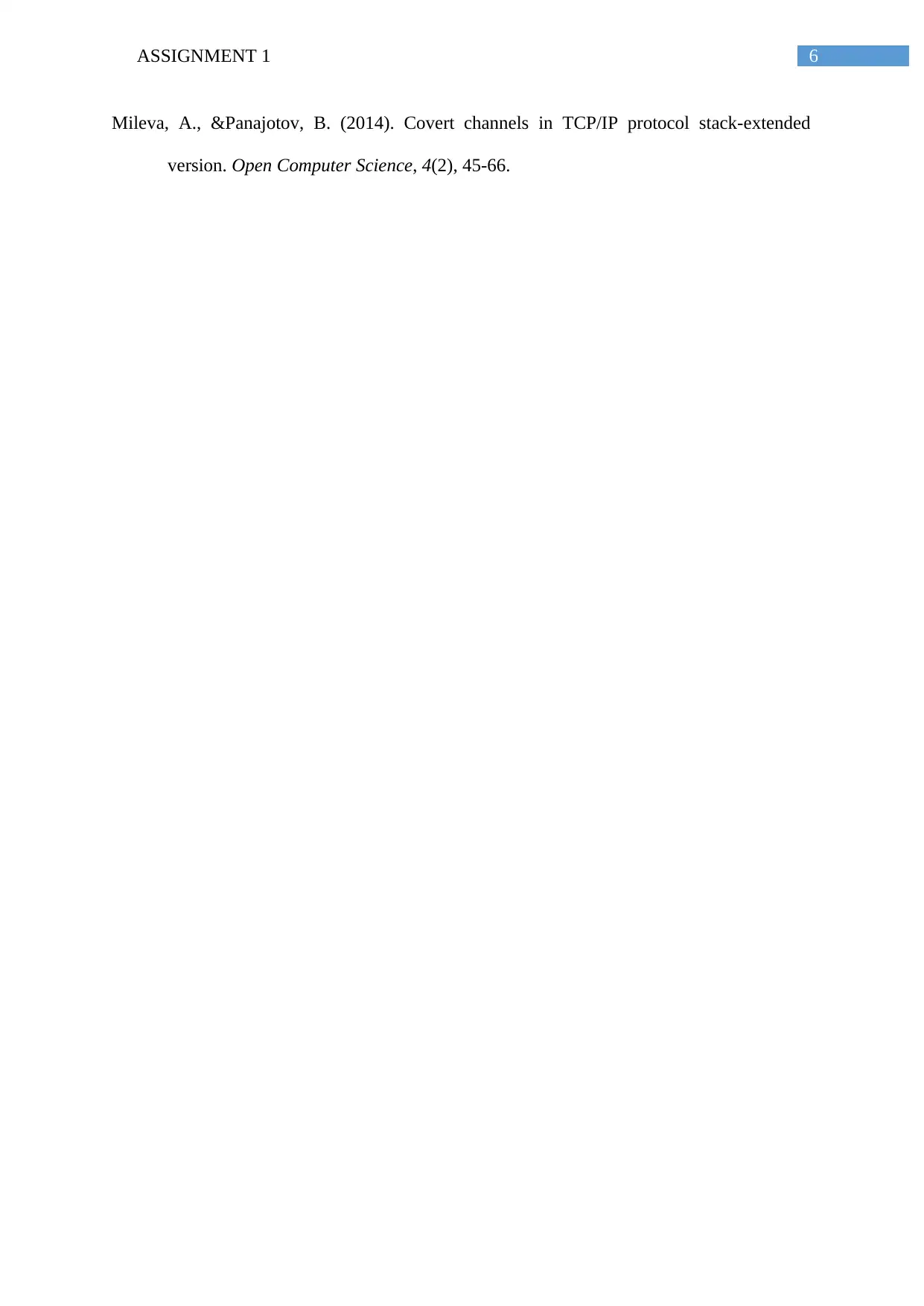
6ASSIGNMENT 1
Mileva, A., &Panajotov, B. (2014). Covert channels in TCP/IP protocol stack-extended
version. Open Computer Science, 4(2), 45-66.
Mileva, A., &Panajotov, B. (2014). Covert channels in TCP/IP protocol stack-extended
version. Open Computer Science, 4(2), 45-66.
1 out of 7
Related Documents
Your All-in-One AI-Powered Toolkit for Academic Success.
+13062052269
info@desklib.com
Available 24*7 on WhatsApp / Email
![[object Object]](/_next/static/media/star-bottom.7253800d.svg)
Unlock your academic potential
© 2024 | Zucol Services PVT LTD | All rights reserved.




